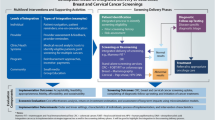Abstract
Screening tests for colon, cervical and breast cancer remain underutilized despite their proven effectiveness in reducing morbidity and mortality. Stone et al. concluded that cancer screening is most likely to improve when a health organization supports performance through organizational changes (OC) in staffing and clinical procedures. OC interventions include the use of separate clinics devoted to prevention, use of a planned care visit, designation of non-physician staff for specific prevention activities and continuous quality improvement interventions. Objectives To identify specific elements of OC interventions that increases the selected cancer screening rates. To determine to which extent practices bought into the interventions. Methods Eleven randomized controlled trials from January 1990 to June 2010 that instituted OC to increase cancer screening completion were included. Qualitative data was analyzed by using a framework to facilitate abstraction of information. For quantitative data, an outcome of measure was determined by the change in the proportion of eligible individuals receiving cancer screening services between intervention and control practices. The health prevention clinic intervention demonstrated a large increase (47%) in the proportion of completed fecal occult blood test; having a non-physician staff demonstrated an increase in mammography (18.4%); and clinical breast examination (13.7%); the planned care visit for prevention intervention increased mammography (8.8%); continuous quality improvement interventions showed mixed results, from an increase in performance of mammography 19%, clinical breast examination (13%); Pap smear (15%) and fecal occult blood test (13%), to none or negative change in the proportion of cancer screening rates. Conclusions To increase cancer screening completion goals, OC interventions should be implemented tailored to the primary care practice style. Interventions that circumvent the physicians were more effective. We could not conclude whether or not continuous quality techniques were effective. Further research is needed to evaluate cost-effectiveness of these interventions.
Similar content being viewed by others
References
US Cancer Statistics Working Group. (2010). United States Cancer Statistics: 1999–2006 incidence and mortality web-based report. Atlanta: US Department of Health and Human Services, Centers for Disease Control and Prevention and National Cancer Institute; [cited 2010 07/15]; Available from: www.cdc.gov/uscs.
FastStats. (2007). Leading causes of death. National Center for Health Statistics. Center for Disease Control. [cited 2010 07/15]; Available from: http://www.cdc.gov/nchs/fastats/lcod.htm.
Medicare Preventive Services. (2010). US Department of Health and Human Services. [cited 2010 07/15]; Available from: http://www.medicare.gov/navigation/manage-your-health/preventive-services/preventive-service-overview.aspx.
Agency for Healthcare Research and Quality. (2010). Guide to clinical preventive services. Cancer. US Department of Health and Human Services. [cited 2010 07/15]; Available from: http://www.ahrq.gov/clinic/cps3dix.htm#cancer.
American Cancer Society. (2010) .Cancer facts & figures. [Report] [cited 2010 07/15]; Available from: http://www.cancer.org/Research/CancerFactsFigures/CancerFactsFigures/cancer-facts-and-figures-2010.
Centers for Disease Control and Prevention. (2010) .Health disparities in cancer. US Department of Health and Human Services. [cited 2010 07/15/2010]; Available from: http://www.cdc.gov/cancer/healthdisparities/.
Breen, N., & Meissner, H. I. (2005). Toward a system of cancer screening in the United States: Trends and opportunities. Annual Review of Public Health, 26, 561–582.
Stone, E. G., et al. (2002). Interventions that increase use of adult immunization and cancer screening services: A meta-analysis. Annals of Internal Medicine, 136(9), 641–651.
Binstock, M. A., et al. (1997). Pap smear outreach: A randomized controlled trial in an HMO. American Journal of Preventive Medicine, 13(6), 425–426.
Herman, C. J., Speroff, T., & Cebul, R. D. (1995). Improving compliance with breast cancer screening in older women. Results of a randomized controlled trial. Archives of Internal Medicine, 155(7), 717–722.
Mohler, P. J. (1995). Enhancing compliance with screening mammography recommendations: A clinical trial in a primary care office. Family Medicine, 27(2), 117–121.
Belcher, D. W. (1990). Implementing preventive services. Success and failure in an outpatient trial. Archives of Internal Medicine, 150(12), 2533–2541.
Williams, R. B., Boles, M., & Johnson, R. E. (1998). A patient-initiated system for preventive health care. A randomized trial in community-based primary care practices. Archives of Family Medicine, 7(4), 338–345.
Solberg, L. I., et al. (2000). Failure of a continuous quality improvement intervention to increase the delivery of preventive services. A randomized trial. Effective Clinical Practice, 3(3), 105–115.
Ruffin, M. T.t., & Gorenflo, D. W. (2004). Interventions fail to increase cancer screening rates in community-based primary care practices. Preventive Medicine, 39(3), 435–440.
Kinsinger, L. S., et al. (1998). Using an office system intervention to increase breast cancer screening. Journal of General Internal Medicine, 13(8), 507–514.
Goodwin, M. A., et al. (2001). A clinical trial of tailored office systems for preventive service delivery. The study to enhance prevention by understanding practice (STEP-UP). American Journal of Preventive Medicine, 21(1), 20–28.
Dietrich, A. J., et al. (1992). Cancer: Improving early detection and prevention. A community practice randomised trial. BMJ, 304(6828), 687–691.
Dietrich, A. J., et al. (1998). Cancer early-detection services in community health centers for the underserved. A randomized controlled trial. Archives of Family Medicine, 7(4), 320–327. (discussion 328).
McLaughlin, C. P. (2006). Continuous quality improvement in health care theory, implementations, and applications (3rd ed.). Sudbury, MA: Jones and Barlett.
Kaiser Permanent. RE-AIM Framework. (2010). Hosted by Kaiser Permanente Colorado Region. Institute for Health Research. Available from: http://www.re-aim.org/. Accessed 15 July 2010.
Acknowledgments
Dr. Arroyave was supported by an American Cancer Society Scholarship. Dr. Lewis was supported by a K07 Mentored Career Development Award (5K07CA104128) from the National Cancer Institute.
Author information
Authors and Affiliations
Corresponding author
Rights and permissions
About this article
Cite this article
Arroyave, A.M., Penaranda, E.K. & Lewis, C.L. Organizational Change: A Way to Increase Colon, Breast and Cervical Cancer Screening in Primary Care Practices. J Community Health 36, 281–288 (2011). https://doi.org/10.1007/s10900-010-9309-7
Published:
Issue Date:
DOI: https://doi.org/10.1007/s10900-010-9309-7




